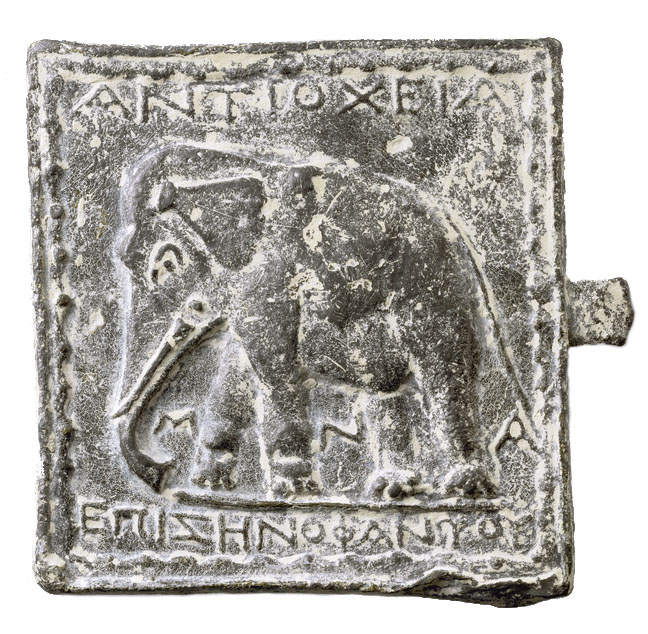
-
Copyright credit: J. Paul Getty Museum

ARCHAEOLOGICAL DESCRIPTION OF THE WEIGHT
Authority
Zenophantos, agoranomos (Antioch)
Mint
Antioch
Denomination
1 Mina
Material
Lead
Manufacture
Cast
Shape
Square
Length
10.80 cm
(4.25 inch)
Width
11.43 cm
(4.5 inch)
Height
- cm
Metrology
| Mass (g) | Mass (grain) | Date of measurement | Reference | fragmented | cleaned | reference weight |
|---|---|---|---|---|---|---|
| 520.00 | 8024.8011 | - | www.getty.edu | No | No | Yes |
Iconography
| Symbol | Technique | Direction | Position | Number | Synecdoche |
|---|---|---|---|---|---|
| Lattice pattern | Relief | ||||
| Elephant | Relief |
Wear
Corrosion
Handle
Yes
Suspension hole
No
Recarved mould
No
Recarved weight
No
Intentionally destroyed
No
Archaeological description
True and Hamma 1994: Late Hellenistic, second-first century B.C. Lead; H: 10.8 cm; w (including projecting tab): 11.5 cm; Weight: 520 g (Mina of Antiochia Syriae). Condition: Intact. The weight has the form of a square plaque. On the obverse, framed by an astragal border, is an elephant walking toward the viewer’s left. Above is inscribed, ΑΝΤΙΟΧΕΙΑ (Antioch); between the elephant’s legs, ΜΝΑ (mina); beneath the ground line, ΕΠΙΖΗΝΟΦΑΝΥΟΥ (under Zenophanes). The reverse has a net pattern in low relief. On one side is a projecting tab. As the tab is attached sideways, which is quite unusual, it may have provided a place where the weight could be shaved down to calibrate its weight. The workmanship of our lead elephant mina is coarser, the relief lower than that displayed by catalogue numbers 94 and 95 above. The reverse with the square network, however, is similar. The medium and design as well as the naming of an official and the late form of the alpha also indicate a later date. As the designation “agoranomos” usual on Roman weights, does not appear, a late Hellenistic date is likely. During this period the Antioch mint was a prolific producer of Seleucid silver coinage, a testimony to the economic importance of that metropolis.
Getty Museum: An Indian elephant decorates the front of this lead weight. The Greek inscriptions surrounding the elephant state that the weight comes from Antioch, the capital of the Seleucid Empire; that it is a mina, the basic unit of weight used in the Seleucid Empire at this time; and that it was made under Zenophanes, who must have been an official in charge of weights and measures. The naming of the official, the form of the letters in the inscription, and the use of lead rather than bronze for an official weight suggest that this piece dates to late in the Hellenistic period. Elephants are a recurring symbol on Seleucid coinage and on official weights, both products of the government mint. Originally connected with Alexander the Great’s conquest to the east as far as India, the symbol was used to stress the dynasty’s role as the legitimate successors of Alexander. Various Seleucid rulers also linked the symbol to victories and treaties of their own in the East. A small tab projects from the right side of the weight. This tab was presumably shaved down to adjust the weight.
Getty Museum: An Indian elephant decorates the front of this lead weight. The Greek inscriptions surrounding the elephant state that the weight comes from Antioch, the capital of the Seleucid Empire; that it is a mina, the basic unit of weight used in the Seleucid Empire at this time; and that it was made under Zenophanes, who must have been an official in charge of weights and measures. The naming of the official, the form of the letters in the inscription, and the use of lead rather than bronze for an official weight suggest that this piece dates to late in the Hellenistic period. Elephants are a recurring symbol on Seleucid coinage and on official weights, both products of the government mint. Originally connected with Alexander the Great’s conquest to the east as far as India, the symbol was used to stress the dynasty’s role as the legitimate successors of Alexander. Various Seleucid rulers also linked the symbol to victories and treaties of their own in the East. A small tab projects from the right side of the weight. This tab was presumably shaved down to adjust the weight.
Autopsy
No
INSCRIPTION
| Language | Technique | Legend type |
|---|---|---|
| Greek | Relief | Authority, Denomination, Mint |
Fac simile
Edition
Ἀντιόχεια | μ–ν–ᾶ | ἐπὶ Ζηνοφάντου
L.3: reversed Ζ – Ξηνοφάντου uel Ζηνοφάντου?
L.3: reversed Ζ – Ξηνοφάντου uel Ζηνοφάντου?
Monogram
ARCHAEOLOGICAL CONTEXT
Findspot (region)
Findspot (site)
context
CIRCUMSTANCES OF ACQUISITION
Region
City
Date of first acquisition
Dec. 31, 1991
circumstances
Gift of Barbara and Lawrence Fleischman (New York, 1925 - New York, 1997) to the J. Paul Getty Museum in 1996. Sold to Barbara and Lawrence Fleischman in 1991, Antiquarium, Ltd. (New York).
DATING OF THE WEIGHT
Curatorial Section
GREEK
Time frame
FROM
-250
TO
-1
Comments on Chronology
2nd – 1st century B.C.
COLLECTION HISTORY
Collection
| Name | Date of acquisition | Inventory number |
|---|---|---|
| Fleischman Collection | Dec. 31, 1991 | F269 |
| Getty Museum – Getty Villa (Malibu) | Dec. 31, 1996 | 96.AI.146 |
Bibliography
| Reference | Page/Column | Reference (number) | Plate / Figure | Comment |
|---|---|---|---|---|
| True and Hamma 1994 | 204–205 | 98 | fig. 98 | None |
| Getty Museum 1997–98 |
VARIA
Additional comment
Permalink